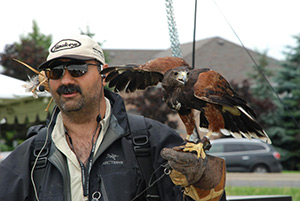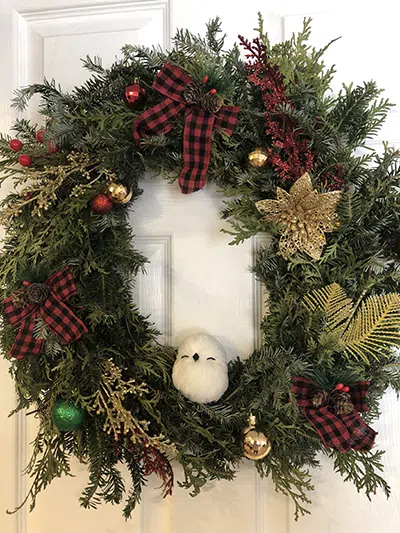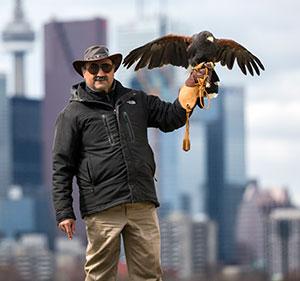Falconry is an age-old practice that involves capturing, training, and keeping birds of prey for use in hunting. Raptors like red-tailed hawks or merlins can be employed to catch small wild game, such as grouse or rabbits, or used to scare off pest birds.
But is falconry legal in Canada?
 Hawkeye's Falconry Experience in Toronto & the GTA
Hawkeye's Falconry Experience in Toronto & the GTA
Falconry, a sport at least 2,000 years old, is still being practiced today in many areas around the world. But is falconry legal in Canada today?
Yes, it is, in fact, legal throughout most of Canada, including B.C., Alberta, Saskatchewan, Ontario, Manitoba, Quebec, Newfoundland and Labrador, Nova Scotia, and PEI. The regulations for raptor hunting and requirements for a falconry licence vary depending on the province.
Nowadays, falconry is mostly considered recreational, with many enthusiasts joining local or global falconry and raptor associations. However, the practice does have some other critical applications such as natural conservation, educational programs, and pest bird control.
When it comes to falconry experience in Ontario, Hawkeye Bird and Animal Control is an expert resource, a Certified Wildlife Control Professional (CWCP) company with a falconry permit.
Hawkeye Bird and Animal Control employs falconry as a humane tool to control behavioural patterns of pest birds naturally. The birds in this category can include pigeons, starlings, sparrows, grackles, seagulls, geese, and more.
We do this via the natural relationship between prey (the pest birds) and their predators (raptors). Birds of prey, also called raptors, can be trained to chase pest birds out of a particular area. This puts instinctual fear into the pest birds, scaring and keeping them away from the area that the raptor patrols.
As a natural form of bird control, falconry actually works quicker and gives more long-lasting results than other methods, such as shooting, trapping, or noise-makers.
Hawkeye Bird and Animal Control offers falconry and bird control services to residential, commercial, and industrial properties and piers in the Greater Toronto Area, Golden Horseshoe, and many parts of Florida. We use falconry to scare away birds that are posing a bird-strike threat to planes at airports and to control congregating problems or nesting infestations at landfills, industrial buildings, recreational areas, and on farmlands.
If Falconry is something that interests you personally, contact Hawkeye today for a once in a lifetime falconry experience where you can handle, fly, and see all of our birds of prey up close and personal including all sorts of hawks, eagles, owls, and falcons.
What Is the Best Bird for Falconry?
With the right knowledge, training, and licencing, you can train a bird of prey using food as a motivator. Essentially, the falconer becomes the raptor’s only source of food, so it will learn to obey commands to get that food as a reward.
But what is the best bird of prey to use for the art of falconry?
Well, that depends on what province or territory you live in, as native bird species can vary across the country.
When you get your falconry apprenticeship licence, you can apply to trap your own native bird of prey.
In Ontario, the four common native falconry birds approved for wild capture are:
- Cooper’s hawk
- Red-tailed hawk
- Sharp-shinned hawk
- Merlin
A red-tailed hawk is an excellent choice for your first raptor, as they are considered relatively easy to care for and work with. Since these common prey birds are indigenous to Ontario, they are acclimated to the Ontario climate and terrain. Their natural prey is also in the area. Another good reason to get a native species is that you can release it back into the wild (with Ministry of Natural Resources and Forestry approval) if you decide not to continue with falconry or if the particular raptor doesn’t work out.
There are a limited number of wild raptor capture applications approved per year in Ontario through a lottery system. You can only capture one prey bird per approved application and must follow strict regulations on what type of bird (i.e. breed, age) you can and cannot trap.
If you’d rather purchase a prey bird from a breeder, you can go with a Harris’s hawk, a non-native species. The female Harris’s hawk may be the better option, as they are larger and can fly faster over longer distances than the male, plus they are often more relaxed in their behaviour.
How Do You Become a Falconer in Ontario?
Falconry is an amazing opportunity to work closely with birds of prey and spend time in the great outdoors. But remember that falconry is a regulated activity in Ontario and the other Canadian provinces that allow it.
When considering getting your falconry licence, you should first understand that raptors do not make good pets. And, to be a falconer, you must be willing and able to actually hunt game with your bird of prey.
Other factors that go into the major commitment of falconry include:
- Space: To train and hunt with your bird, you need legal access to a good amount of land that contains its natural prey and that’s free of hazards. Things that can be dangerous to a raptor include wires, air traffic, high-traffic roads, and dogs.
- Mews: You also need to provide the proper amount of space in terms of their housing (i.e. mews), depending on the breed and size of your raptor. For example, the average red-tailed hawk needs an 8’ x 8’ x 8’ hawk house, with both indoor (sheltered) and outdoor space, plus access to a water bath for a few hours every day. You need to make sure they are protected from the weather; whether it’s heat, cold, precipitation, or wind. Lastly, your mews must be in a quiet, stress-free area and must be secure against predators, such as dogs, cats, and coyotes.
- Equipment/Supplies: Do your homework on what specific equipment and supplies you’ll need for the raptor’s housing facility as well as for training and hunting. Perches, anklets/jesses, leashes, swivels, bells, lures, gloves, hoods, a scale, food, and vitamin supplements are just some examples of what you’ll need.
- Time: Training, housing, and hunting with a bird of prey is a substantial time commitment. Falconry is not a casual hobby. You need to spend several hours each day training or flying your bird. You also have to be in it for the long haul. Some birds live longer than 30 years in captivity.
How Do I Get a Falconry Licence in Ontario?
For Ontarians who are fully committed to the many demands and challenges of learning falconry, the next step is to look into how to get a falconry licence in Ontario. Licensing requirements vary between provinces, so check your provincial government’s website for details if you live outside of Ontario.
Before you get one of the following licences and start to hunt with a native Ontario raptor, you first need to have a small game hunting licence for Ontario.
Once you move on to getting your falconry licence and bird of prey, you must place an identification band on the bird. You also must keep a logbook that records your name and licence number, the species and band number of your bird of prey, and all details on any falconry event you take part in. If your bird suffers an injury or dies, this also must be logged. You’re required by law to keep all of your log records on file for a minimum of five years.
If you’re planning to hunt with a non-native bird of prey, you actually don’t need a falconry licence. But you do still need to follow all of the other requirements just mentioned.
Apprentice Falconry Licence
Before you can practice falconry with a native raptor, you have to get your apprentice falconry licence. To attain this, you need your small game hunting license, as mentioned, and you must also work as an apprentice with an experienced falconer.
Another requirement is that you complete the Ontario Hawking Club Apprenticeship Program, involving 30 hours of classroom-based and/or field falconry instruction for 15 months. This period must span two Octobers.
Once you’ve met these requirements, you can apply for your General Falconry Licence.
About six weeks after you apply for your apprentice falconry licence, you can submit your application to capture a wild raptor. With your apprentice licence, you may only keep one bird of prey, but once you’ve advanced to your general licence you are then allowed to house up to three birds of prey.
General Falconry Licence
Armed with your small game hunting license and successful completion of the Ontario Hawking Club Apprenticeship Program, you can apply to the Ministry of Natural Resources and Forestry for your general falconry licence.
You may also be eligible for this licence if you have already had an Ontario general falconry licence at some point within the last five years or if you practiced falconry with your own bird of prey in another jurisdiction for at least two years in a row within the last five years.
Be prepared to wait about six weeks to hear back about your application.
Commercial Falconry Licence
The commercial falconry licence allows a falconer to breed birds of prey, keep more than three raptors at once, and also to use them in other commercial applications, such as airport bird control.
To get this designation, you must have your small game hunting license and have had your general falconry licence for at least five years (or can show that you’ve been training and housing raptors for that same period). Again, you’ll need to wait about six weeks to hear back from your Ministry of Natural Resources and Forestry district office once you’ve applied.
How Much Does It Cost to Become a Falconer?
For those dedicated enough to become a falconer, there are, of course, associated costs. These can vary quite a bit, depending on where you live, what type of falconer license(s) you go for, what type of bird you get, and how many birds you get. Here are some examples of what you’re looking at if you live in Ontario (note: this is not a comprehensive list):
- Outdoors card: $8.57
- One-Stop Hunter Education Program (including gun safety): $200.00-$300.00
- Small game licence: Approx. $22.76 per year
- Apprentice falconry licence: $20.00
- Mews: $300.00-$2,000, depending on your setup and construction
- Equipment: Anywhere from $150.00 to $700.00 for the basics
- Food: $500.00 per year, on average
Overall, you can anticipate spending $1,500 to $2,000 at first, and then adding on the daily costs, like food, on top of that. And getting into commercial falconry costs exponentially more. So, it’s clear that falconry is a significant monetary investment, on top of the time commitment, so there’s a lot to consider carefully before starting on the path to falconry.
Hawkeye Bird and Animal Control offers falconry and bird control services to residential, commercial, and industrial properties and piers in the Greater Toronto Area, Golden Horseshoe, and many parts of Florida. Email us at [email protected] or call us at (416) 429-5393 or toll-free at 1-(855) 393-4295, for expert falconry assistance. Interested in testing out the birds of prey experience? We offer falconry workshops at our facility just outside of Toronto.
Hawkeye is the ONLY Toronto and Golden Horseshoe area licensed Pest Bird Control Specialist offering PERMANENT REMOVAL & GUARANTEED RESULTS. We are uniquely qualified under permits and licenses to PERMANENTLY REMOVE AND CONTROL pest birds such as pigeons, seagulls, geese, starlings, and swallows using a variety of methods including Birds of Prey. Additionally, we offer cleaning and disinfecting of affected areas and facilitate the future exclusion of birds.
Now with 7 Locations ( 6 In Canada and 1 in the U.S), we are ready to serve you better in Acton, Toronto, Oshawa, Bowmanville, two locations in Mississauga and West Palm Beach in Florida.
Contact us today or Email us at [email protected] if you need help with pest bird control and/or pest bird removal.
Pest Birds like Cormorants, Crows, Ducks, Doves, Geese, Grackels, Seagulls, Pigeons, Robins, Sparrows and Starlings.Related Articles: How to become a Falconer in Florida














